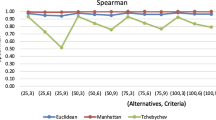Abstract
The chapter presents a definition of composite decision making problems as problems consisting in choosing desired actions in the case when they are connected with additional undesired effects. It is assumed that the undesired effects cannot be evaluated but by their pair-wise relative comparison. There are defined algebraic tools which can be effectively used to solution of composite decision making problem: the operations of balancing and extension of preferences and of direct balancing, direct extension and structural product of matrices describing the corresponding semi-ordering relations. Application of the algebraic tools to solution of several types of composite decision making problems is illustrated by numerical examples. Conclusions are formulated in the last section of the chapter.
Access this chapter
Tax calculation will be finalised at checkout
Purchases are for personal use only
Similar content being viewed by others
References
Cormen TH, Leiserson CE, Rivest RL (1994) Introduction to algorithms, 13th printing. The MIT, Cambridge
de Bono E (1969) The mechanism of mind. Mica Management Resources Inc., UK
Dennet DC (1996) Kind of minds: towards an understanding of consciousness. http://en.wikipedia.org/wiki/Daniel_Dennett. Accessed 5 Jan 2013
Hempel CG (1937) A purely topological form of non-Aristotelian logic. J Symbolic Logic 2(3)
Kulikowski JL (1986) Outline of the theory of graphs. PWN, Warsaw
Kulikowski JL (1992) Relational approach to structural analysis of images. Mach Graph Vis 1(1/2):299–309
Michalewicz Z, Fogel DB (2004) How to solve it: modern heuristics. Springer, Berlin
Myers DG (2004) Intuition its powers and perils. Yale University Press, New Haven
Penrose R (1994) Shadows of the mind a search for the missing science of consciousness. Oxford University Press, Oxford
Peschel M, Riedel C (1976) Polyoptimierung. VEB Verlag Technik, Berlin
Rudeanu S (2012) Sets and ordered structures. Bentham Science Publishers, Karachi
Russel S, Norvig P (2003) Artificial intelligence: a modern approach. Prentice Hall, Pearson Education Inc, Upper Saddle River
Author information
Authors and Affiliations
Corresponding author
Editor information
Editors and Affiliations
Rights and permissions
Copyright information
© 2014 Springer International Publishing Switzerland
About this chapter
Cite this chapter
Kulikowski, J.L. (2014). Computer-Aided Relative Assessment of Complex Effects of Decisions. In: S. Hippe, Z., L. Kulikowski, J., Mroczek, T., Wtorek, J. (eds) Issues and Challenges in Artificial Intelligence. Studies in Computational Intelligence, vol 559. Springer, Cham. https://doi.org/10.1007/978-3-319-06883-1_9
Download citation
DOI: https://doi.org/10.1007/978-3-319-06883-1_9
Published:
Publisher Name: Springer, Cham
Print ISBN: 978-3-319-06882-4
Online ISBN: 978-3-319-06883-1
eBook Packages: EngineeringEngineering (R0)




